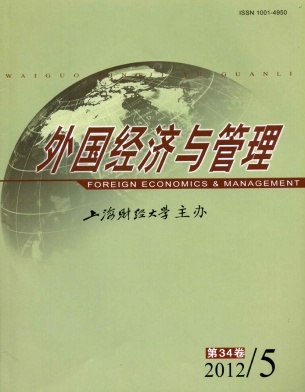红桃皇后竞争理论研究综述与展望
外国经济与管理 2012 年 第 34 卷第 05 期, 页码:45 - 51
摘要
参考文献
摘要
红桃皇后竞争理论是近年来提出的一种新的竞争理论。本文在文献梳理的基础上,首先对红桃皇后竞争理论的发展脉络、作用机制和内在意蕴进行了回顾,然后从理论传统、关注焦点等层面对相关的代表性实证研究进行了比较和述评,最后从战略管理研究的角度对红桃皇后竞争理论的未来发展趋势进行了展望。
[1]Barnett,et al.An evolutionary model of organizational per-formance[J].Strategic Management Journal,1994,15(S.I.):11-28.
[2]Barnett W P and Hansen M T.The red queen in organization evolution[J].Strategic Management Journal,1996,17(S.I.):139-157.
[3]Barnett W P.The dynamics of competitive intensity[J].Stra-tegic Management Journal,1997,42(1):128-160.
[4]Barnett W P and Sorenson O.The red queen in organization creation and development[J].Industrial and Corporate Change,2002,11(2):289-325.
[5]Barnett W P and McKendrick D.Why are some organizations more competitive than others?Evidence from a changing global market[J].Administrative Science Quarterly,2004,49(4):535-571.
[6]Barnett W P and Pontikes E G.The red queen:History-de-pendent competition among organizations[J].Research in Or-ganization Behavior,2005,26(2):351-371.
[7]Barnett W P and Pontikes E G.The red queen,success bias,and organizational inertia[J].Management Science,2008,54(7):1237-1251.
[8]Barney J B and Hoskisson.Strategic groups:Untested asser-tions and research proposals[J].Managerial and Decision E-conomics,1990,11(3):187-198.
[9]Chen M-J and MacMillan I C.Nonresponse and delayed re-sponse to competitive moves:The roles of competitor depen-dence and action irreversibility[J].Academy of Management Journal,1992,35(3):359-370.
[10]Chen M-J and Miller D.Competitive attack,retaliation and performance:An expectancy-valence framework[J].Strate-gic Management Journal,1994,15(2):85-102.
[11]Chen M-J.Competitor analysis and inter-firm rivalry:To-ward a theoretical integration[J].Academy of Management Review,1996,21(1):100-134.
[12]Chen M-J.Competitive dynamics research:An insider’s odyssey[J].Asia Pacific Journal of Management,2009,26(1):5-25.
[13]Chen M-J.Reflecting on the process:Building competitive dynamics research[J].Asia Pacific Journal of Management,2010,27(1):9-24.
[14]Cyert R M and March J G.A behavioral theory of the firm[M].Engelwood Cliffs,NJ:Prentice-Hall,1963.
[15]Derfus P J,et al.The red queen effect:Competitive actions and firm performance[J].Academy of Management Journal,2008,51(1):61-80.
[16]Ferrier W J.Navigating the competitive landscape:The dri-vers and consequences of competitive aggressiveness[J].A-cademy of Management Journal,2001,44(4):858-877.
[17]Gibson C B and Birkinshaw J.The antecedents,consequences and mediating role of organizational ambidexterity[J].Aca-demy of Management Journal,2004,47(2):209-226.
[18]Gimeno J and Woo C Y.Multimarket contact,economies of scope,and firm performance[J].Academy of Management Journal,1999,42(2):239-259.
[19]Haunschild P R and Miner A S.Modes of interorganizational imitation:The effects of salience and uncertainty[J].Admin-istrative Science Quarterly,1997,42(3):472-500.
[20]Haveman H A and Nonnemaker L.Competition in multiple geographic markets:The impact on growth and market entry[J].Administrative Science Quarterly,2000,45(2):232-267.
[21]Ingram P.Interorganizational Learning[A].Baum J A C(Ed.).Companion to organizations[C].New York:Black-well,2002:642-663.
[22]Levinthal D A and March J G.A model of adaptive organiza-tional search[J].Journal of Economic Behavior and Organi-zation,1981,2(4):307-333.
[23]Levitt B and March J G.Organizational learning[A].Scott W R(Ed.).Annual review of sociology[C].Palo Alto,CA:Annual Reviews,1988:319-340.
[2]Barnett W P and Hansen M T.The red queen in organization evolution[J].Strategic Management Journal,1996,17(S.I.):139-157.
[3]Barnett W P.The dynamics of competitive intensity[J].Stra-tegic Management Journal,1997,42(1):128-160.
[4]Barnett W P and Sorenson O.The red queen in organization creation and development[J].Industrial and Corporate Change,2002,11(2):289-325.
[5]Barnett W P and McKendrick D.Why are some organizations more competitive than others?Evidence from a changing global market[J].Administrative Science Quarterly,2004,49(4):535-571.
[6]Barnett W P and Pontikes E G.The red queen:History-de-pendent competition among organizations[J].Research in Or-ganization Behavior,2005,26(2):351-371.
[7]Barnett W P and Pontikes E G.The red queen,success bias,and organizational inertia[J].Management Science,2008,54(7):1237-1251.
[8]Barney J B and Hoskisson.Strategic groups:Untested asser-tions and research proposals[J].Managerial and Decision E-conomics,1990,11(3):187-198.
[9]Chen M-J and MacMillan I C.Nonresponse and delayed re-sponse to competitive moves:The roles of competitor depen-dence and action irreversibility[J].Academy of Management Journal,1992,35(3):359-370.
[10]Chen M-J and Miller D.Competitive attack,retaliation and performance:An expectancy-valence framework[J].Strate-gic Management Journal,1994,15(2):85-102.
[11]Chen M-J.Competitor analysis and inter-firm rivalry:To-ward a theoretical integration[J].Academy of Management Review,1996,21(1):100-134.
[12]Chen M-J.Competitive dynamics research:An insider’s odyssey[J].Asia Pacific Journal of Management,2009,26(1):5-25.
[13]Chen M-J.Reflecting on the process:Building competitive dynamics research[J].Asia Pacific Journal of Management,2010,27(1):9-24.
[14]Cyert R M and March J G.A behavioral theory of the firm[M].Engelwood Cliffs,NJ:Prentice-Hall,1963.
[15]Derfus P J,et al.The red queen effect:Competitive actions and firm performance[J].Academy of Management Journal,2008,51(1):61-80.
[16]Ferrier W J.Navigating the competitive landscape:The dri-vers and consequences of competitive aggressiveness[J].A-cademy of Management Journal,2001,44(4):858-877.
[17]Gibson C B and Birkinshaw J.The antecedents,consequences and mediating role of organizational ambidexterity[J].Aca-demy of Management Journal,2004,47(2):209-226.
[18]Gimeno J and Woo C Y.Multimarket contact,economies of scope,and firm performance[J].Academy of Management Journal,1999,42(2):239-259.
[19]Haunschild P R and Miner A S.Modes of interorganizational imitation:The effects of salience and uncertainty[J].Admin-istrative Science Quarterly,1997,42(3):472-500.
[20]Haveman H A and Nonnemaker L.Competition in multiple geographic markets:The impact on growth and market entry[J].Administrative Science Quarterly,2000,45(2):232-267.
[21]Ingram P.Interorganizational Learning[A].Baum J A C(Ed.).Companion to organizations[C].New York:Black-well,2002:642-663.
[22]Levinthal D A and March J G.A model of adaptive organiza-tional search[J].Journal of Economic Behavior and Organi-zation,1981,2(4):307-333.
[23]Levitt B and March J G.Organizational learning[A].Scott W R(Ed.).Annual review of sociology[C].Palo Alto,CA:Annual Reviews,1988:319-340.
引用本文
于鸣, 汪金爱, 段野. 红桃皇后竞争理论研究综述与展望[J]. 外国经济与管理, 2012, 34(5): 45–51.
导出参考文献,格式为:
上一篇:企业战略行为研究述评
下一篇:开放式创新实证研究述评与未来展望





 6371
6371  526
526

